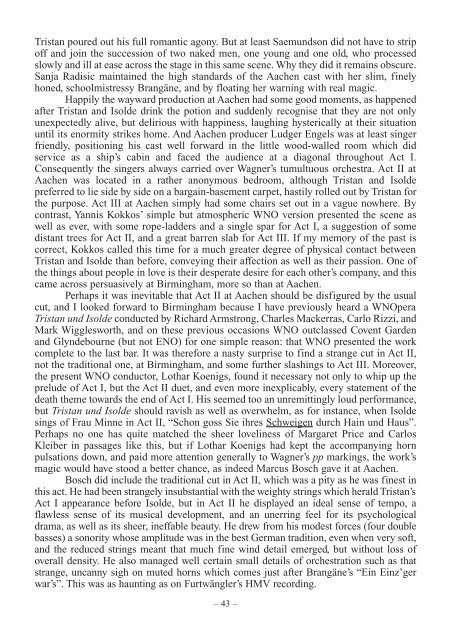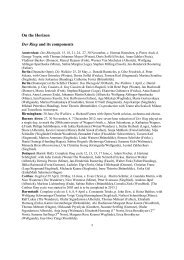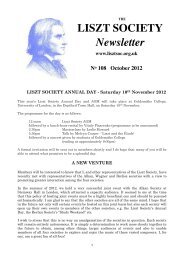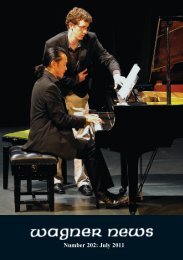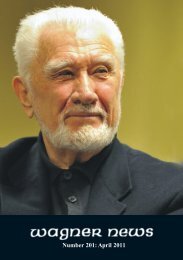13895 Wagner News 174 - Wagner Society of England
13895 Wagner News 174 - Wagner Society of England
13895 Wagner News 174 - Wagner Society of England
You also want an ePaper? Increase the reach of your titles
YUMPU automatically turns print PDFs into web optimized ePapers that Google loves.
Tristan poured out his full romantic agony. But at least Saemundson did not have to strip<br />
<strong>of</strong>f and join the succession <strong>of</strong> two naked men, one young and one old, who processed<br />
slowly and ill at ease across the stage in this same scene. Why they did it remains obscure.<br />
Sanja Radisic maintained the high standards <strong>of</strong> the Aachen cast with her slim, finely<br />
honed, schoolmistressy Brangäne, and by floating her warning with real magic.<br />
Happily the wayward production at Aachen had some good moments, as happened<br />
after Tristan and Isolde drink the potion and suddenly recognise that they are not only<br />
unexpectedly alive, but delirious with happiness, laughing hysterically at their situation<br />
until its enormity strikes home. And Aachen producer Ludger Engels was at least singer<br />
friendly, positioning his cast well forward in the little wood-walled room which did<br />
service as a ship’s cabin and faced the audience at a diagonal throughout Act I.<br />
Consequently the singers always carried over <strong>Wagner</strong>’s tumultuous orchestra. Act II at<br />
Aachen was located in a rather anonymous bedroom, although Tristan and Isolde<br />
preferred to lie side by side on a bargain-basement carpet, hastily rolled out by Tristan for<br />
the purpose. Act III at Aachen simply had some chairs set out in a vague nowhere. By<br />
contrast, Yannis Kokkos’ simple but atmospheric WNO version presented the scene as<br />
well as ever, with some rope-ladders and a single spar for Act I, a suggestion <strong>of</strong> some<br />
distant trees for Act II, and a great barren slab for Act III. If my memory <strong>of</strong> the past is<br />
correct, Kokkos called this time for a much greater degree <strong>of</strong> physical contact between<br />
Tristan and Isolde than before, conveying their affection as well as their passion. One <strong>of</strong><br />
the things about people in love is their desperate desire for each other’s company, and this<br />
came across persuasively at Birmingham, more so than at Aachen.<br />
Perhaps it was inevitable that Act II at Aachen should be disfigured by the usual<br />
cut, and I looked forward to Birmingham because I have previously heard a WNOpera<br />
Tristan und Isolde conducted by Richard Armstrong, Charles Mackerras, Carlo Rizzi, and<br />
Mark Wigglesworth, and on these previous occasions WNO outclassed Covent Garden<br />
and Glyndebourne (but not ENO) for one simple reason: that WNO presented the work<br />
complete to the last bar. It was therefore a nasty surprise to find a strange cut in Act II,<br />
not the traditional one, at Birmingham, and some further slashings to Act III. Moreover,<br />
the present WNO conductor, Lothar Koenigs, found it necessary not only to whip up the<br />
prelude <strong>of</strong> Act I, but the Act II duet, and even more inexplicably, every statement <strong>of</strong> the<br />
death theme towards the end <strong>of</strong> Act I. His seemed too an unremittingly loud performance,<br />
but Tristan und Isolde should ravish as well as overwhelm, as for instance, when Isolde<br />
sings <strong>of</strong> Frau Minne in Act II, “Schon goss Sie ihres Schweigen durch Hain und Haus”.<br />
Perhaps no one has quite matched the sheer loveliness <strong>of</strong> Margaret Price and Carlos<br />
Kleiber in passages like this, but if Lothar Koenigs had kept the accompanying horn<br />
pulsations down, and paid more attention generally to <strong>Wagner</strong>’s pp markings, the work’s<br />
magic would have stood a better chance, as indeed Marcus Bosch gave it at Aachen.<br />
Bosch did include the traditional cut in Act II, which was a pity as he was finest in<br />
this act. He had been strangely insubstantial with the weighty strings which herald Tristan’s<br />
Act I appearance before Isolde, but in Act II he displayed an ideal sense <strong>of</strong> tempo, a<br />
flawless sense <strong>of</strong> its musical development, and an unerring feel for its psychological<br />
drama, as well as its sheer, ineffable beauty. He drew from his modest forces (four double<br />
basses) a sonority whose amplitude was in the best German tradition, even when very s<strong>of</strong>t,<br />
and the reduced strings meant that much fine wind detail emerged, but without loss <strong>of</strong><br />
overall density. He also managed well certain small details <strong>of</strong> orchestration such as that<br />
strange, uncanny sigh on muted horns which comes just after Brangäne’s “Ein Einz’ger<br />
war’s”. This was as haunting as on Furtwängler’s HMV recording.<br />
– 43 –


